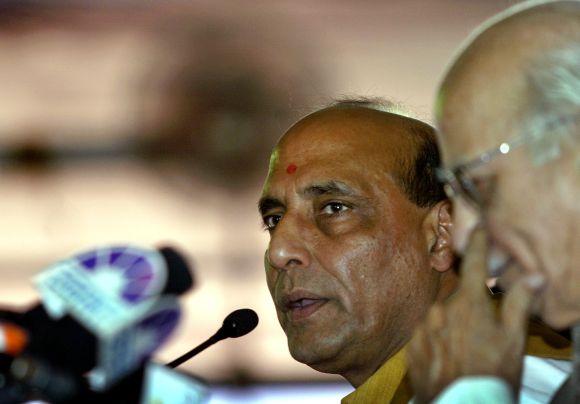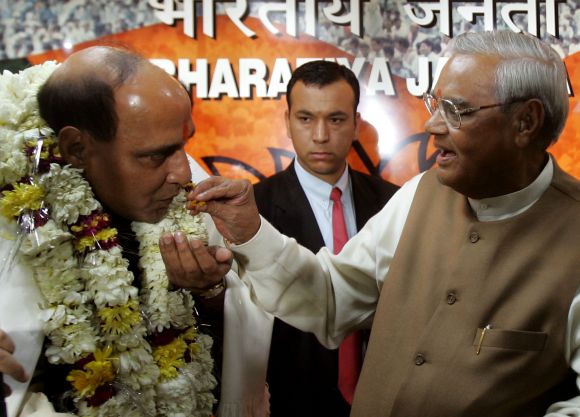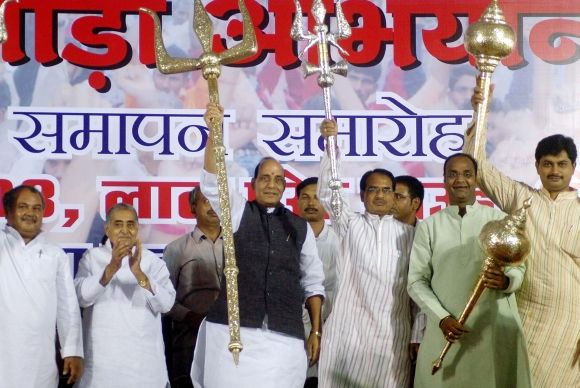Photographs: Reuters Sharat Pradhan
Sharat Pradhan chronicles Rajnath Singh's political journey -- from a farmer's family to chief, for the second time, of Bharatiya Janata Party.
Rajnath Singh, who was elected president of Bharatiya Janata Party on Wednesday, finds himself in the familiar role of leading the party at a time when the party is dogged by factional feud and the Lok Sabha polls not too far away.
Rajnath Singh, 62, hails from village Babhora, Tehsil Chakia, in Uttar Pradesh's Chandauli district, which was carved out of Varanasi a few years ago.
Born in a farmer's family on July 10, 1951, Singh did his early education in the village itself but was sent to Gorakhpur for his higher education from where he graduated and obtained a masters degree in physics.
With inputs from PTI
Please ...
From physics prof to BJP's 'commoner' president
Image: Rajnath Singh with senior BJP leader L K AdvaniPhotographs: Reuters
Initially, he chose to take up teaching as his career and was lucky to get lecturership in physics at the K B Post-Graduate College in Mirzapur, close to his native place.
He had been a Rashtriya Swayamsewak Sangh volunteer right from his childhood, and it was in recognition of his involvement with various activities of the organisation, that he was appointed 'karyavah' (secretary) of RSS Mirzapur city unit in 1972.
Singh made his debut into student politics in 1969 while he was pursuing his degree at the Gorakhpur University, and was soon made organisation secretary of the local unit of Akhil Bhartiya Vidyarthi Parishad.
While displaying his leadership qualities as ABVP leader, he drew the attention of UP BJP leadership who named him secretary of Mirzapur unit of then Bharatiya Jana Sangh in 1974. Within a year he rose to head the district unit of the party
Rajnath Singh was hand-picked as the district coordinator for the movement launched by Jai Prakash Narayan. And that gave him his first stint in jail together with all those who had opposed the Emergency.
Please ...
From physics prof to BJP's 'commoner' president
Image: Rajnath Singh with Gujarat Chief Minister Narendra ModiPhotographs: Reuters
But the reward came in the form of a sweeping win as a young MLA in 1977.
In 1983, he was made state secretary of BJP and 1984 he was given charge as sate chief of BJP's Youth Wing -- Bhartiya Janata Yuva Morch. Two years later he was elevated as national general secretary of BJYM, and in 1988, he rose further to become the BJYM national president. It was then that he also wrote a book on 'Unemployment -- its Reasons and Remedies'.
The same year he also got elected to the UP legislative council and when the BJP formed its first government in 1991, Rajnath Singh was inducted as UP's education minister.
That was the turning point in his career as certain initiatives taken by him put him on a distinctly higher pedestal than many of his equals in the party.
And what made him famous was the anti-copying act whereby use of unfair means in examinations was made a cognisable offence.
While introduction of Vedic Mathematics in the syllabus brought him laurels from various quarters, it were certain interpolations in the history text books that threw him into avoidable controversies.
Please ...
From physics prof to BJP's 'commoner' president
Image: Rajnath Singh with former Prime Minister Atal Bihari VajpayeePhotographs: Reuters
Rajnath Singh became MP Rajya Sabha in 1994 and also the party's chief whip in the upper House.
Thereafter, there was no looking for the dynamic young leader, who was entrusted with the all important task of UP BJP president in 1997.
Two years later, when Atal Behari Vajpayee became prime minister, Rajnath Singh was named Union surface transport minister and it was during his stint that India witnessed launching of the country's National Highway Development Programme.
Singh became the chief minister of Uttar Pradesh on October 28, 2000. Considering that it was a time of crisis for the party, Singh did a great job and was responsible for building a positive image for the party.
In May 2003, he became Union minister for agriculture and food processing and made his mark within no time by initiating schemes like creation of Kisan Call Centres and introduction of farm insurance.
In July 2004, he was appointed national general secretary of the BJP for the second time -- with charge of two states -- Chhattisgarh and Jharkhand. And the party's victory in both the states at the assembly elections earned him laurels.
On December 31, 2005, Rajnath Singh was unanimously elected as the BJP president, thereby taking him to new heights.
He traversed the length and breadth of the country to highlight the unabated rise of terrorism. He also focused on common man's issues like rising prices, besides making efforts to remove the "anti-Muslim" tag of the party.
Please ...
From physics prof to BJP's 'commoner' president
Image: Rajnath Singh with MP Chief Minister Shivraj Singh Chauhan at a rally in BhopalPhotographs: Reuters
Political observers see him as a potential architect for further building the BJP as a broader-based party.
Singh is married with two sons and a daughter.
Singh's dramatic elevation to the top party post caps a period of big political churnings within BJP divided on re-electing Gadkari as president for a second time.
It was Singh who had handed over the baton to Gadkari in December 2009. But in a sudden and dramatic last-minute twist, Gadkari, facing allegations of dubious funding of his company, was last night forced out of the race for BJP president's post for a second term and Rajnath emerged the consensus choice.
The party probably had little choice except to fall back on Singh's non-controversial image and a high degree of acceptability among rival groups in the organisation.
Singh has again been brought back by the party as chief just three days after the Congress elevated All India Congress Committee general secretary Rahul Gandhi as vice president.
How Singh will reshape the BJP to counter Congress' charm offensive remains to be seen though he has often lauded BJP's democratic strength which has enabled a "commoner" like him to lead the party.






article